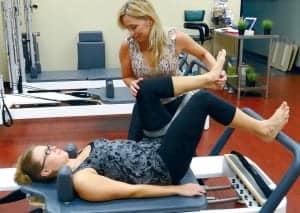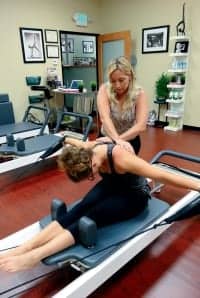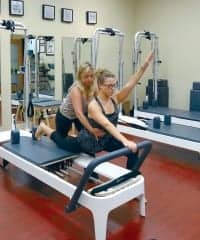
Dawn-Marie Ickes, MPT, PMACPT, uses hip distraction at different angles combined with bone rhythms during movement on the Pilates A2 Reformer while treating a young dancer.
Physical therapists are recognized universally as providers of fitness, health promotion, and wellness, yet many physical therapy practices are devoid of programs designed to enhance quality of life for persons across their lifespan. As the category of prevention and wellness demonstrates an emerging niche where health care dollars are spent by the millions, there is increased demand for therapists to demonstrate and highlight their expertise in preventative wellness.
Integrating Pilates into a physical therapy practice represents one of the simplest and most cost-effective ways to introduce the concept of the physical therapist as a wellness practitioner and preventative health expert. Many models for cash-pay “a la carte” services require the use of expensive programming, software, certifications, and staff. These models also may include skills and concepts not easily utilized in each phase of rehabilitation, which can make the transition from discharge to a wellness program challenging. But one piece of equipment, the Reformer, can lay the foundation for the development of cash-pay programming. Practice owners can begin small and with low risk, while determining how best to incorporate Pilates into the clinic setting, community, and overall business plan. Many believe that for Pilates to be successful within a therapy practice, those programs should have the same large footprint found in the traditional Pilates studio. This thinking is erroneous, yet more often than not owners embrace this perception and jump quickly to adopt Pilates in their clinics without a solid plan and significant research. Small yet specific programming can be far more profitable with reduced risk.
ESTABLISHING A MODEL SYSTEM

The author (pictured here) uses neuromuscular facilitation and patterning of scapula-thoracic rhythm with combined movements of the spine and shoulder girdle.

Dawn-Marie Ickes, MPT, PMA-CPT, combines the proprioceptive input of the Pilates A2 Reformer and myofascial sling activation to improve functional stability.
Tapping into the inherent cross-marketing opportunities within the practice that can promote Pilates provides a cost-effective way to grow a practice. The move to access new and expanded populations as individuals move between therapy and fitness in a clinic can be effortless. In the traditional physical therapy setting, patients are often discharged with a home program and sent on their way. By integrating wellness programming into the practice model, the client can be retained within the business in a manner that benefits both the practice and the client simultaneously. The result is the creation of more autonomy and independence for the “patient” as they transition to becoming a “client.” Furthermore, the practice itself benefits from the independence created from a cash-pay service model.
Home programming and “wellness” compliance are improved as patients now have a resource or a place to go for support, education, and trouble-shooting should any issues arise following discharge. This model creates a continuum of care beyond what has been seen in the traditional clinical setting.
REHAB REFORM
One of the most important elements in developing any new programming is introducing existing clients to Pilates. Those individuals represent 50% to 60% of the future referral base. With the introduction of Pilates equipment into a patient’s current treatment plan, the idea of practicing Pilates becomes less intimidating and its benefits are experienced early in the rehabilitation process.
The single most versatile piece of Pilates equipment is the Reformer. It is designed with space saving options and adaptations to ensure its usability for any patient population. Some models can safely stack upright, leaving ample floor space when not in use, and others convert easily to a padded table. These qualities can make the Reformer an optimal device in anchoring a new Pilates program.
The Reformer also can ease the physical introduction to Pilates for individuals who have injuries. By design, the Reformer supports the body in a variety of functional positions during movement. It also provides options for direct utilization during all phases of rehabilitation from facilitating one-on-one joint mobilization to group exercise classes. Specialized training in use of the Reformer does not happen overnight, but its use in the rehabilitation setting can begin sooner than may be anticipated. Many therapists begin their course work and start using the Reformer as the modality of choice for strengthening and neuromuscular reeducation among their patients. The concept of starting small, while the larger plan is being mapped out, is an excellent way to introduce Pilates programming to the existing client base, and build excitement and enthusiasm around the wellness programming to come. It also allows adequate time to become educated in Pilates as a preventative wellness option for fitness as well as learn about its role in rehabilitation.
PILATES PRACTICE PERFECTED
Creating a seamless transition from physical therapy to fitness can take a little effort but in the long run can be worth it. An introduction to Pilates prior to discharge can be established early in the rehabilitation process by simply integrating Pilates exercises into the treatment plan based on areas of need. Within this framework, programming options can increase participation; some examples include a “post-rehabilitation transition” package offered to all discharged patients at a discounted rate; “specialty population” Reformer classes guided by a physical therapist or specialty trained Pilates instructor; and lecture/demonstration sessions about prevention. If cost is an issue, the “self-directed workout” is another option. Upon discharge, a very specific program is created that the client can safely practice independently within the facility.
The practice itself experiences the benefits of utilizing PT expertise integrated with Pilates and wellness, as there is increased drive to stay in-house throughout the rehabilitation to fitness transition. A solid sustainable model is established that is not dependent on third-party (insurance) payors, and assists with future planning based on easily tracked profit projections.
EXAMPLES OF PROGRAMS THAT WORK
Some participants in “specialty clinic programming” can convert from being clinic patients to conventional clients for either private Pilates or physical therapy. This type of offering provides tremendous gains in networking, public relations, and exposure in a specific community, with minimal effort other than coordinating a schedule. By providing education and support to help patients/clients make choices that will promote health, clinicians encourage the “goal of wellness,” to give people greater awareness and control in making choices about their own health.
Another example includes the Breast Cancer Awareness Clinic offered at Evolve Integrative Wellness, in Rancho Santa Margarita, Calif. The studio offers 30 minutes of treatment and a 30-minute group class on the Reformer for appropriate participants. The physical therapist sees two clinic attendees per hour for treatment and follow-up with a post-breast cancer specific Pilates class. The fee is $40 for the treatment and $10 for the class. The group Reformer/Trap/CoreAlign class size is limited to four so it encourages safety, consistency, and responsibility (participants need to sign up ahead of time to ensure a spot).
In addition to existing clients who easily transition into “post-rehabilitation fitness,” “wellness/fitness,” and “specialty populations” (ie, fibromyalgia, multiple sclerosis, rheumatoid arthritis), a list of ideal populations to feed into a wellness model combined with specialized programming includes firefighters, police and public service workers, corporate and industrial health and wellness, performing artists, athletes, local sports clubs, aging population, and youth.
Cash-based “specialty clinic” programming can be structured to fill off-peak hours, balance staff productivity, and offer a reduction in fees for those who cannot otherwise afford services. This enables those with financial limits to participate while working with a high level of expertise.
As physical therapy moves toward the vision of PT 2020, physical therapists will be universally recognized and promoted as the practitioners of choice for persons with conditions that affect movement, function, health, and wellness. Now is the time for physical therapists to highlight their inherently programmed expertise for prevention and wellness education, which has been deeply ingrained in our practice from the beginning. This evolution in how physical therapy is perceived, delivered, and practiced will not only prove to benefit businesses, but the patients, clients, consumers, and communities that are seeking the information, education, and advice only physical therapists can provide.
Dawn-Marie Ickes, MPT, PMA-CPT, holds a BS in Biology from Loyola Marymount University and a Master’s degree in Physical Therapy from Mount St Mary’s College. She is the owner of Evolve Integrative Wellness Physical Therapy & Pilates, specializing in corrective exercise for sports performance, integrative wellness and dance medicine. She is adjunct faculty for California State University, Northridge, and Mount St Mary’s College DPT programs. For more information, contact or visit www.ievolvept.com.





